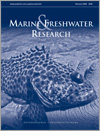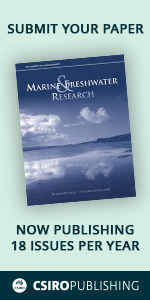Marine and Freshwater Research
Volume 69
Number 8 2018
In this study, we provide a methodology for quantifying and communicating uncertainty associated with water quality predictions. We show how exceedance probabilities can identify hot spots for future monitoring or remediation activities, and how these can be used to inform water quality target-setting activities. The approach is tested in the Upper Burdekin catchment, which drains to the Great Barrier Reef.
Herein we report on the emergence of abnormal skin lesions in a wild-caught serranid fish (Epinephelus quoyanus). The lesion involves conspicuous darkening and disorganisation of the typical colouration pattern of this species. Since it was first observed in 2012, the prevalence of the lesion increased to 16.9% in 2017. Fish >340 mm long are most affected (prevalence 64.7%), suggesting that causative factors, although currently unknown, may be age related.
Knowledge of how Australian native fish respond to changes in river flows is essential to inform the restoration of these flows. However, most recommendations are based on expert knowledge. We used systematic methods to review the literature on several Australian fish species, but found very little relevant evidence. This demonstrates the need for targeted monitoring and research to fill these important knowledge gaps.
This study compares fish assemblages of permanently open estuaries and intermittently closed and open lakes or lagoons (ICOLLs) in Otago, New Zealand. The results indicated that estuary–ocean connection and season play a key role in structuring fish assemblage structure of estuaries.
In this study, we observed the seasonal recruitment patterns, analysed temporal variations in early growth rates using daily increments in the otolith and assessed the effects of environmental variables on the growth rate of juvenile mud carp (Cirrhinus molitorella), one of the most important commercial fish species in the Pearl River, in China.
We showed how variability in otolith shape can be used to reflect isolation and connectivity within and among stocks of Patagonian toothfish across the Patagonian Shelf, and South Georgia and the South Sandwich Islands (SGSSI). Differences in otolith shape indicated clear differentiation between, as well as within, these two regional groupings. The results suggest that despite some degree of connectivity, large-scale mixing of adult toothfish across the Patagonian Shelf and SGSSI is limited.
Wrack is common in surf zones of sandy beaches, yet few studies have investigated food webs in those environments. From samples of wrack and fauna in South Australian surf zones, we established baseline food webs based on stable isotopes and fish gut contents. Fish feed among wrack, but also forage elsewhere, and macroinvertebrates do use wrack as a food source.
We investigated the day-to-day movements and habitat use of the threatened Australian grayling by using radio-telemetry in the Bunyip River. Tagged fish typically occupied restricted reaches of stream, and were mostly located in moderate- to fast-flowing habitats. They also undertook longer-distance downstream movements during a period of increased streamflow. This information is vital to Australian grayling conservation management.
This study investigated relationships between hydrological regime and the germination and buoyancy of tangled lignum and nitre goosefoot seeds. Tangled lignum germinated best on soaked soil and soil inundated for 20 days. Nitre goosefoot germinated best on soil inundated for 5 days and soaked soil. Seeds of tangled lignum floated for longer than seeds of nitre goosefoot (≥7 v. ≤7 days respectively).
Plants grow by using light for photosynthesis. In a study of a tropical river, we show that the types of plants and the shade within the plants affect their efficiency in using light for photosynthesis. This has implications for the use of photosynthesis to monitor river health, especially when using photosynthesis to monitor the amount of plant biomass.
In arid and semi-arid coastal areas, groundwater is the main source of water supply. Therefore, an understanding of the mechanisms and processes that control the mineralisation and the recharge mode of this resource remain essential to ensure its management and protection. The example held in this study is the Essaouira Basin (Morocco), to which the hydrogeochemical and isotopic approach has been applied.
Chilean silverside (Basilichthys microlepidotus) is a native fish that inhabits the Mataquito River (Maule Region). The environmental factors in the Mataquito River determining the dominant habitat of this freshwater fish were unknown. A habitat suitability model was used to describe the dependence of Chilean silverside on relevant physicochemical, hydromorphological and biological parameters. The present study identified habitat suitability for the Chilean silverside using geospatial analysis tools.
We examined surface and subterranean sites in a Neotropical stream in order to compare the fish fauna composition and its relationship with physical habitat traits. Canopy cover and organic matter on the streambed accounted for most of the variation in fish fauna. Characiformes (tetras) was the richest group, but Siluriformes (catfish) have greater chances of occupying subterranean habitats.
This study has shown a new technique to control asterinid grazers in field experiments. The efficiency of alternative methods (sticky barrier and antifouling paint) for field manipulations of the cushion star, Parvulastra exigua, was tested. The authors found that antifouling paint can retain starfish within plots delimited by the paint, whereas sticky barriers will be crossed by the starfish.
An invasive, non-native fish in the Iberian Peninsula, the common bleak threatens Iberia’s valuable endemic freshwater fauna. Wide inter-population variability in growth and reproduction was found across the main Iberian rivers and a ‘reference’ native population from France. These results may aid to mitigate impacts exerted by this bio-invasion on the endangered fish communities of Mediterranean Europe.




